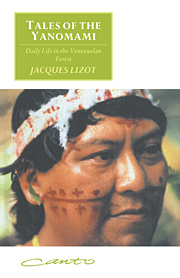Summary
While the hunt was in progress, the guests traveled the distance that separated them from Karohi. The women shouldered the heavy burden of domestic utensils and green plantains, of little children running at their side or riding on the baskets. Now the guests are camping in the forest, near Karohi, waiting to receive the official invitation, the teshomomou, before entering their hosts' dwelling to participate in the festivities and the rituals.
The temporary camp occupied by the people of Hōkanakawë – that is the name given to their shabono standing at the very top of the mountain of the same name – includes about eighty persons. The shelters, with their triangular bases, have been built in a circle within the forest; the undergrowth in the center has been cut and thrown to the outside. Around the camp rises a hedge of branches planted in the ground and secured with vines, for protection against warriors, sorcerers who “blow” their poisons, and ghosts who steal souls. For longer-lasting roofs and for better protection from rain, they have selected miyōma leaves instead of the usual ketiba leaves, which deteriorate too quickly.
The morning sun slanting into the forest strikes the huts with its blinding shafts. On the transverse poles of the shelters are displayed long strips of red cloth as evidence of both the group's wealth and its generosity.
The place is infested with bloodsucking insects, and the Indians are continually slapping their sides and backs to drive them away; only the coming of night puts an end to this constant torment.
- Type
- Chapter
- Information
- Tales of the YanomamiDaily Life in the Venezuelan Forest, pp. 157 - 186Publisher: Cambridge University PressPrint publication year: 1991

